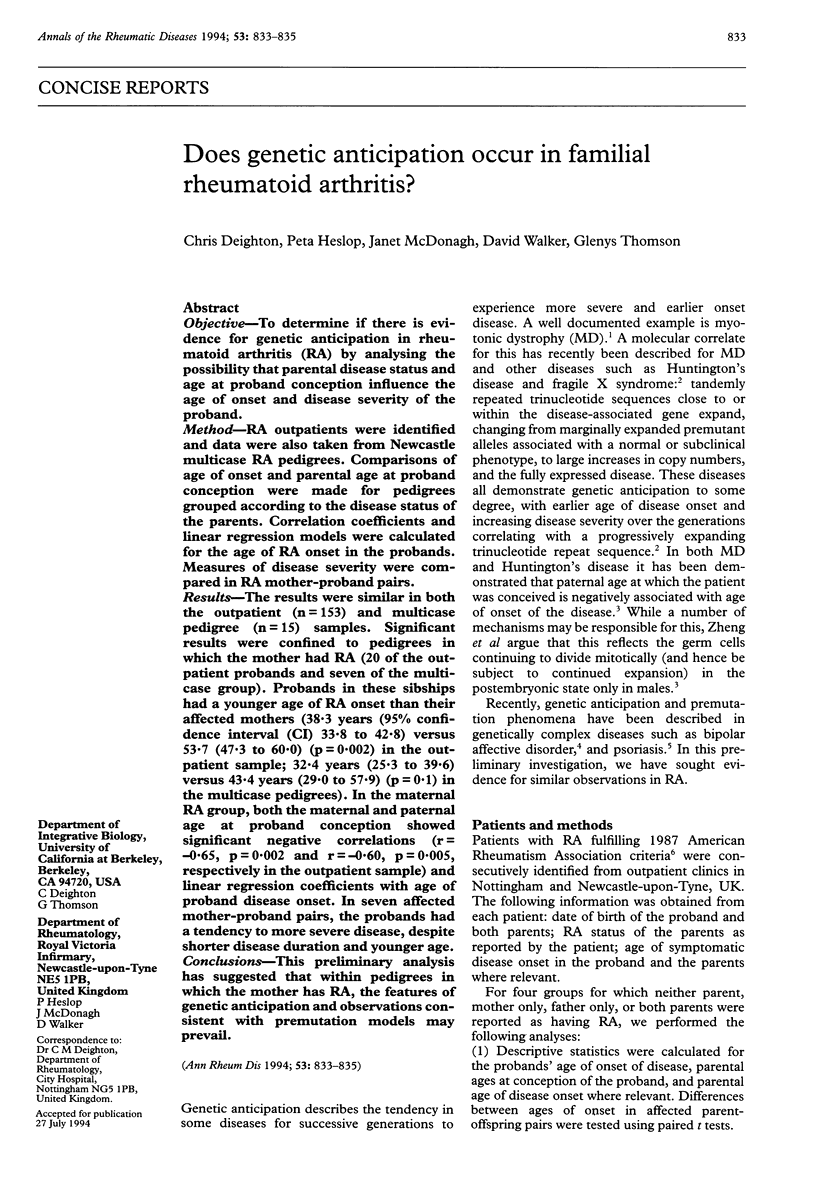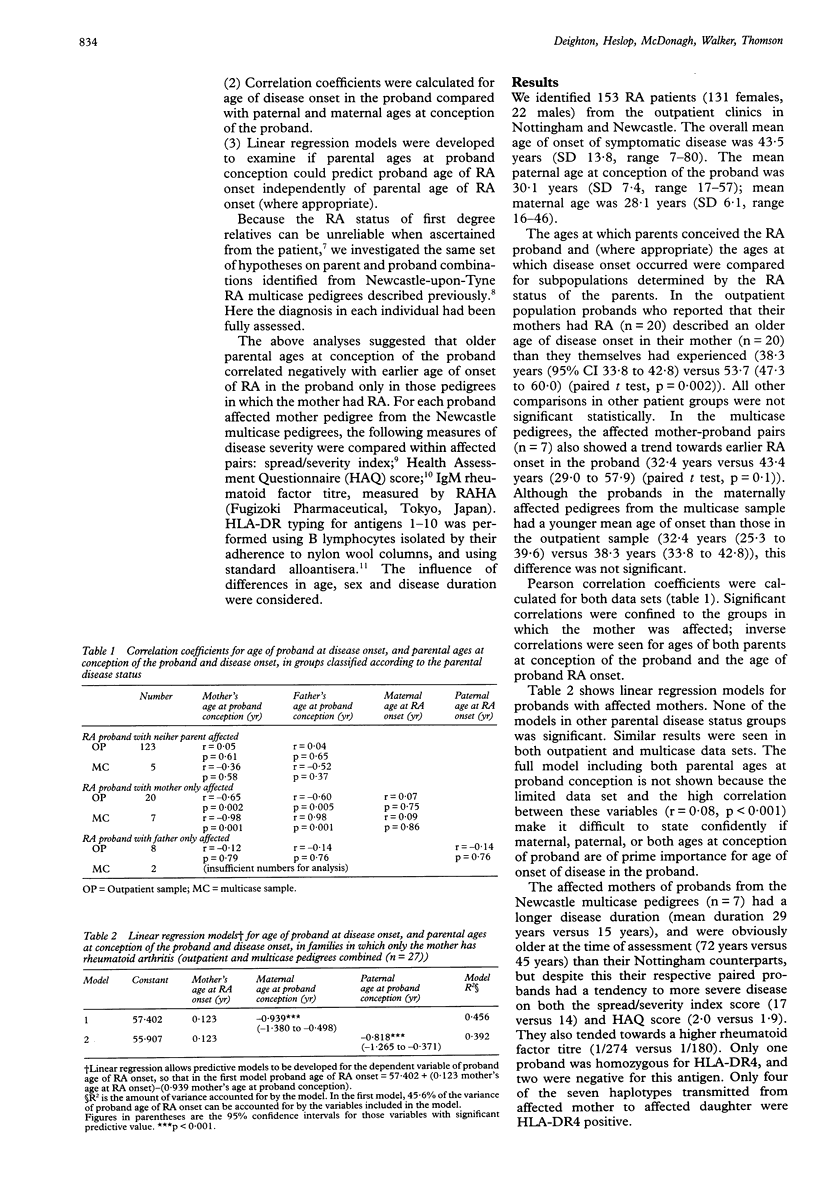Abstract
OBJECTIVE--To determine if there is evidence for genetic anticipation in rheumatoid arthritis (RA) by analysing the possibility that parental disease status and age at proband conception influence the age of onset and disease severity of the proband. METHOD--RA outpatients were identified and data were also taken from Newcastle multicase RA pedigrees. Comparisons of age of onset and parental age at proband conception were made for pedigrees grouped according to the disease status of the parents. Correlation coefficients and linear regression models were calculated for the age of RA onset in the probands. Measures of disease severity were compared in RA mother-proband pairs. RESULTS--The results were similar in both the outpatient (n = 153) and multicase pedigree (n = 15) samples. Significant results were confined to pedigrees in which the mother had RA (20 of the outpatient probands and seven of the multicase group). Probands in these sibships had a younger age of RA onset than their affected mothers (38.3 years (95% confidence interval (CI) 33.8 to 42.8) versus 53.7 (47.3 to 60.0) (p = 0.002) in the outpatient sample; 32.4 years (25.3 to 39.6) versus 43.4 years (29.0 to 57.9) (p = 0.1) in the multicase pedigrees). In the maternal RA group, both the maternal and paternal age at proband conception showed significant negative correlations (r = -0.65, p = 0.002 and r = -0.60, p = 0.005, respectively in the outpatient sample) and linear regression coefficients with age of proband disease onset. In seven affected mother-proband pairs, the probands had a tendency to more severe disease, despite shorter disease duration and younger age. CONCLUSIONS--This preliminary analysis has suggested that within pedigrees in which the mother has RA, the features of genetic anticipation and observations consistent with premutation models may prevail.
Full text
PDF


Selected References
These references are in PubMed. This may not be the complete list of references from this article.
- Arnett F. C., Edworthy S. M., Bloch D. A., McShane D. J., Fries J. F., Cooper N. S., Healey L. A., Kaplan S. R., Liang M. H., Luthra H. S. The American Rheumatism Association 1987 revised criteria for the classification of rheumatoid arthritis. Arthritis Rheum. 1988 Mar;31(3):315–324. doi: 10.1002/art.1780310302. [DOI] [PubMed] [Google Scholar]
- COBB S., THOMPSON D. J., ROSENBAUM J., WARREN J. E., MERCHANT W. R. On the measurement of prevalence of arthritis and rheumatism from interview data. J Chronic Dis. 1956 Feb;3(2):134–139. doi: 10.1016/0021-9681(56)90109-6. [DOI] [PubMed] [Google Scholar]
- Goronzy J. J., Weyand C. M. Interplay of T lymphocytes and HLA-DR molecules in rheumatoid arthritis. Curr Opin Rheumatol. 1993 Mar;5(2):169–177. doi: 10.1097/00002281-199305020-00008. [DOI] [PubMed] [Google Scholar]
- Gregersen P. K. Discordance for autoimmunity in monozygotic twins. Are "identical" twins really identical? Arthritis Rheum. 1993 Sep;36(9):1185–1192. doi: 10.1002/art.1780360902. [DOI] [PubMed] [Google Scholar]
- Harper P. S., Harley H. G., Reardon W., Shaw D. J. Anticipation in myotonic dystrophy: new light on an old problem. Am J Hum Genet. 1992 Jul;51(1):10–16. [PMC free article] [PubMed] [Google Scholar]
- Kirwan J. R., Reeback J. S. Stanford Health Assessment Questionnaire modified to assess disability in British patients with rheumatoid arthritis. Br J Rheumatol. 1986 May;25(2):206–209. doi: 10.1093/rheumatology/25.2.206. [DOI] [PubMed] [Google Scholar]
- McConkie-Rosell A., Lachiewicz A. M., Spiridigliozzi G. A., Tarleton J., Schoenwald S., Phelan M. C., Goonewardena P., Ding X., Brown W. T. Evidence that methylation of the FMR-I locus is responsible for variable phenotypic expression of the fragile X syndrome. Am J Hum Genet. 1993 Oct;53(4):800–809. [PMC free article] [PubMed] [Google Scholar]
- McInnis M. G., McMahon F. J., Chase G. A., Simpson S. G., Ross C. A., DePaulo J. R., Jr Anticipation in bipolar affective disorder. Am J Hum Genet. 1993 Aug;53(2):385–390. [PMC free article] [PubMed] [Google Scholar]
- Ross C. A., McInnis M. G., Margolis R. L., Li S. H. Genes with triplet repeats: candidate mediators of neuropsychiatric disorders. Trends Neurosci. 1993 Jul;16(7):254–260. doi: 10.1016/0166-2236(93)90175-l. [DOI] [PubMed] [Google Scholar]
- Silman A. J. Trends in the incidence and severity of rheumatoid arthritis. J Rheumatol Suppl. 1992 Jan;32:71–73. [PubMed] [Google Scholar]
- Walker D. J., Burn J., Griffiths I. D., Roberts D. F., Stephenson A. M. Linkage studies of HLA and rheumatoid arthritis in multicase families. Arthritis Rheum. 1987 Jan;30(1):31–35. doi: 10.1002/art.1780300104. [DOI] [PubMed] [Google Scholar]
- Walker D. J., Griffiths I. D. HLA associations are with severe rheumatoid arthritis. Dis Markers. 1986 Jun;4(1-2):121–132. [PubMed] [Google Scholar]
- Zheng C. J., Byers B., Moolgavkar S. H. Allelic instability in mitosis: a unified model for dominant disorders. Proc Natl Acad Sci U S A. 1993 Nov 1;90(21):10178–10182. doi: 10.1073/pnas.90.21.10178. [DOI] [PMC free article] [PubMed] [Google Scholar]


